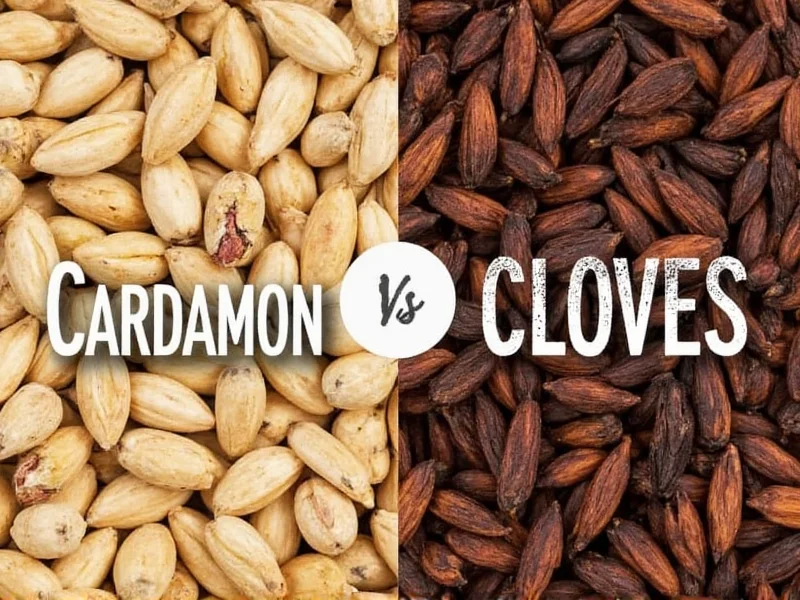Understanding the differences between cardamom and cloves is essential for home cooks and professional chefs alike. These two spices frequently appear in global cuisines but serve distinctly different purposes in the kitchen. While both enhance savory and sweet dishes, their flavor profiles, chemical compositions, and traditional uses create significant divergence in how they transform recipes.
Botanical Origins and Physical Characteristics
Cardamom belongs to the Zingiberaceae family (ginger family) and grows as a perennial herb in tropical climates. Green cardamom (Elettaria cardamomum) features small triangular pods containing black seeds, while black cardamom (Amomum subulatum) has larger, smokier pods. The pods measure approximately 1-2 cm in length with a pale green to yellow color.
Cloves, by contrast, come from the Myrtaceae family and develop as unopened flower buds on Syzygium aromaticum trees. These small, nail-shaped buds measure about 1.5-2 cm with a dark brown to reddish-brown color and a pronounced stem end. The distinctive shape inspired their name from the Latin clavus, meaning "nail."
| Characteristic | Cardamom | Cloves |
|---|---|---|
| Botanical Source | Seed pods of Elettaria/Amomum plants | Dried flower buds of Syzygium trees |
| Primary Flavor Compounds | 1,8-cineole, α-terpinyl acetate | Eugenol (70-90%), β-caryophyllene |
| Flavor Profile | Citrusy, herbal, slightly sweet with eucalyptus notes | Intensely warm, bitter, numbing with medicinal notes |
| Common Forms | Whole pods, seeds, ground | Whole buds, ground |
| Shelf Life (Whole) | 2-3 years | 2-3 years |
Flavor Profiles and Culinary Applications
Cardamom's flavor profile features bright citrus notes with herbal undertones and subtle sweetness. Green cardamom provides a delicate, floral character ideal for both sweet and savory applications, while black cardamom offers a more intense, smoky flavor suited primarily for savory dishes. In Scandinavian baking, cardamom enhances breads and pastries, while Indian cuisine uses it in chai, biryanis, and curries. Middle Eastern cooking incorporates cardamom into rice dishes, meats, and coffee preparations.
Cloves deliver a powerful, warming sensation with pronounced bitterness and a distinctive numbing quality. Their high eugenol content creates that characteristic "bite" that can overwhelm other flavors if used excessively. Culinary traditions worldwide use cloves sparingly in specific applications: Indian garam masala, Chinese five-spice powder, pickling solutions, ham glazes, and mulled beverages. The intense flavor means recipes typically call for just one or two whole cloves to infuse dishes without dominating.
Substitution Guidelines: When Can You Swap Them?
Understanding cardamom vs cloves substitution possibilities prevents recipe disasters. These spices aren't direct substitutes due to their dramatically different flavor profiles. However, in certain contexts, partial substitutions might work:
- Cardamom substitute options: Equal parts cinnamon and coriander with a pinch of nutmeg can mimic cardamom's warmth without the citrus notes. For Scandinavian baking, a combination of allspice and ginger works better.
- Cloves substitute options: Allspice provides the closest approximation of cloves' warmth without the intense bitterness. For recipes requiring whole cloves (like ham glazing), star anise offers a similar visual element with different flavor.
- Never substitute directly: Replacing cardamom with cloves (or vice versa) at equal measurements will dramatically alter your dish's flavor balance.
Health Benefits Comparison
Both spices offer notable health properties supported by scientific research, though their mechanisms differ significantly. Cardamom contains compounds that may support digestive health and exhibit antioxidant properties. Studies suggest cardamom extract demonstrates potential anti-inflammatory effects and may help maintain healthy blood pressure levels when consumed as part of a balanced diet.
Cloves contain exceptionally high levels of eugenol, which research indicates may provide dental pain relief and antimicrobial benefits. The Journal of Agricultural and Food Chemistry published findings showing cloves have one of the highest antioxidant capacities among common spices. However, their intense compounds mean moderation is essential—excessive consumption may cause oral irritation or interact with blood-thinning medications.
Storage and Maximum Freshness
To preserve flavor integrity when comparing cardamom vs cloves, proper storage matters significantly. Both spices maintain optimal freshness longer in whole form compared to ground. Store whole cardamom pods in airtight containers away from light and heat—the delicate essential oils degrade faster than cloves' more stable compounds. Cardamom typically retains peak flavor for 18-24 months when stored properly.
Cloves' high eugenol content makes them more stable during storage. Keep whole cloves in dark glass containers to protect from light exposure, which can accelerate flavor degradation. Properly stored cloves maintain strong flavor for 2-3 years. Never store either spice near heat sources like stoves, as temperature fluctuations diminish volatile aromatic compounds essential to their distinctive profiles.
Buying Guide: Selecting Quality Spices
When purchasing cardamom, look for plump, intact green pods with visible black seeds inside. Avoid pods that feel lightweight (indicating dried-out seeds) or show signs of mold. For black cardamom, seek pods with a strong smoky aroma and uniform dark color. Ground cardamom should have a vibrant green color—not dull or brownish—which indicates freshness.
Quality cloves appear uniformly dark brown with a slight oil sheen on the surface. They should feel heavy for their size and emit a strong, penetrating aroma when crushed. Avoid cloves that look dry, brittle, or lack fragrance, as these indicate age and flavor loss. Always purchase from reputable spice merchants who can verify harvest dates, as freshness dramatically impacts the cardamom vs cloves experience in your cooking.
Traditional Pairings and Cultural Significance
Culinary traditions have refined cardamom and cloves usage over centuries. In Indian cooking, cardamom frequently appears in milk-based sweets like kheer and rice dishes such as biryani, while cloves feature prominently in meat curries and spice blends like garam masala. Scandinavian baking relies heavily on cardamom in breads and pastries, whereas cloves traditionally flavor German gingerbread and mulled wines.
Middle Eastern coffee preparation showcases cardamom's versatility, with freshly crushed pods added directly to brewing coffee. Cloves play essential roles in Chinese five-spice powder and are fundamental to Indonesian kretek cigarettes. Understanding these cultural contexts helps explain why certain recipes specify one spice over the other—these pairings developed through generations of culinary refinement.











 浙公网安备
33010002000092号
浙公网安备
33010002000092号 浙B2-20120091-4
浙B2-20120091-4